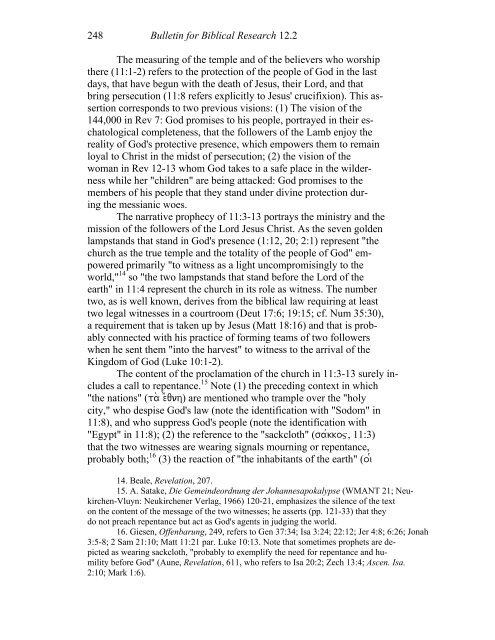John and the Future of the Nations - Institute for Biblical Research
John and the Future of the Nations - Institute for Biblical Research
John and the Future of the Nations - Institute for Biblical Research
You also want an ePaper? Increase the reach of your titles
YUMPU automatically turns print PDFs into web optimized ePapers that Google loves.
248 Bulletin <strong>for</strong> <strong>Biblical</strong> <strong>Research</strong> 12.2<br />
The measuring <strong>of</strong> <strong>the</strong> temple <strong>and</strong> <strong>of</strong> <strong>the</strong> believers who worship<br />
<strong>the</strong>re (11:1-2) refers to <strong>the</strong> protection <strong>of</strong> <strong>the</strong> people <strong>of</strong> God in <strong>the</strong> last<br />
days, that have begun with <strong>the</strong> death <strong>of</strong> Jesus, <strong>the</strong>ir Lord, <strong>and</strong> that<br />
bring persecution (11:8 refers explicitly to Jesus' crucifixion). This assertion<br />
corresponds to two previous visions: (1) The vision <strong>of</strong> <strong>the</strong><br />
144,000 in Rev 7: God promises to his people, portrayed in <strong>the</strong>ir eschatological<br />
completeness, that <strong>the</strong> followers <strong>of</strong> <strong>the</strong> Lamb enjoy <strong>the</strong><br />
reality <strong>of</strong> God's protective presence, which empowers <strong>the</strong>m to remain<br />
loyal to Christ in <strong>the</strong> midst <strong>of</strong> persecution; (2) <strong>the</strong> vision <strong>of</strong> <strong>the</strong><br />
woman in Rev 12-13 whom God takes to a safe place in <strong>the</strong> wilderness<br />
while her "children" are being attacked: God promises to <strong>the</strong><br />
members <strong>of</strong> his people that <strong>the</strong>y st<strong>and</strong> under divine protection during<br />
<strong>the</strong> messianic woes.<br />
The narrative prophecy <strong>of</strong> 11:3-13 portrays <strong>the</strong> ministry <strong>and</strong> <strong>the</strong><br />
mission <strong>of</strong> <strong>the</strong> followers <strong>of</strong> <strong>the</strong> Lord Jesus Christ. As <strong>the</strong> seven golden<br />
lampst<strong>and</strong>s that st<strong>and</strong> in God's presence (1:12, 20; 2:1) represent "<strong>the</strong><br />
church as <strong>the</strong> true temple <strong>and</strong> <strong>the</strong> totality <strong>of</strong> <strong>the</strong> people <strong>of</strong> God" empowered<br />
primarily "to witness as a light uncompromisingly to <strong>the</strong><br />
world," 14 so "<strong>the</strong> two lampst<strong>and</strong>s that st<strong>and</strong> be<strong>for</strong>e <strong>the</strong> Lord <strong>of</strong> <strong>the</strong><br />
earth" in 11:4 represent <strong>the</strong> church in its role as witness. The number<br />
two, as is well known, derives from <strong>the</strong> biblical law requiring at least<br />
two legal witnesses in a courtroom (Deut 17:6; 19:15; cf. Num 35:30),<br />
a requirement that is taken up by Jesus (Matt 18:16) <strong>and</strong> that is probably<br />
connected with his practice <strong>of</strong> <strong>for</strong>ming teams <strong>of</strong> two followers<br />
when he sent <strong>the</strong>m "into <strong>the</strong> harvest" to witness to <strong>the</strong> arrival <strong>of</strong> <strong>the</strong><br />
Kingdom <strong>of</strong> God (Luke 10:1-2).<br />
The content <strong>of</strong> <strong>the</strong> proclamation <strong>of</strong> <strong>the</strong> church in 11:3-13 surely includes<br />
a call to repentance. 15 Note (1) <strong>the</strong> preceding context in which<br />
"<strong>the</strong> nations" (ta_ e!qnh) are mentioned who trample over <strong>the</strong> "holy<br />
city," who despise God's law (note <strong>the</strong> identification with "Sodom" in<br />
11:8), <strong>and</strong> who suppress God's people (note <strong>the</strong> identification with<br />
"Egypt" in 11:8); (2) <strong>the</strong> reference to <strong>the</strong> "sackcloth" (sa/kkoj, 11:3)<br />
that <strong>the</strong> two witnesses are wearing signals mourning or repentance,<br />
probably both; 16 (3) <strong>the</strong> reaction <strong>of</strong> "<strong>the</strong> inhabitants <strong>of</strong> <strong>the</strong> earth" (oi(<br />
14. Beale, Revelation, 207.<br />
15. A. Satake, Die Gemeindeordnung der Johannesapokalypse (WMANT 21; Neukirchen-Vluyn:<br />
Neukirchener Verlag, 1966) 120-21, emphasizes <strong>the</strong> silence <strong>of</strong> <strong>the</strong> text<br />
on <strong>the</strong> content <strong>of</strong> <strong>the</strong> message <strong>of</strong> <strong>the</strong> two witnesses; he asserts (pp. 121-33) that <strong>the</strong>y<br />
do not preach repentance but act as God's agents in judging <strong>the</strong> world.<br />
16. Giesen, Offenbarung, 249, refers to Gen 37:34; Isa 3:24; 22:12; Jer 4:8; 6:26; Jonah<br />
3:5-8; 2 Sam 21:10; Matt 11:21 par. Luke 10:13. Note that sometimes prophets are depicted<br />
as wearing sackcloth, "probably to exemplify <strong>the</strong> need <strong>for</strong> repentance <strong>and</strong> humility<br />
be<strong>for</strong>e God" (Aune, Revelation, 611, who refers to Isa 20:2; Zech 13:4; Ascen. Isa.<br />
2:10; Mark 1:6).
















